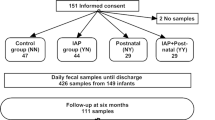Abstract
To investigate the effects of mode of delivery and of necrotising enterocolitis on the faecal microflora, 140 infants born before 33 weeks of gestation were followed up for symptoms of necrotising enterocolitis. Stool samples for gas–liquid chromatography and culture were collected twice weekly, and, when necrotising enterocolitis was suspected, for 2 months. For each infant with necrotising enterocolitis (n=21), two control infants matched for birth weight and gestational age were selected from the remaining study population. In gas–liquid chromatography analysis, the faecal bacterial microflora of infants born via caesarean section differed significantly from the gut microflora of those born via the vaginal route. The intestinal microflora showed a significant alteration in the necrotising enterocolitis group at time of diagnosis. At the onset of necrotising enterocolitis, faecal colonisation with Enterococcus species and Candida albicans was significantly more frequent in symptomatic infants than in controls. In infants with positive blood cultures and positive intestinal biopsy cultures, concomitant stool samples revealed the same microbial pathogens. In conclusion, the intestinal microbial colonisation in preterm infants born by caesarean section differs from that in preterm infants born via the vaginal route. A significant change in faecal microbial colonisation seems to occur at the onset of necrotising enterocolitis. Pathogens detected in the stools at that time might have a causative role in the development of the disease.


Similar content being viewed by others
References
Rotimi VO, Duerden BI (1981) The development of the bacterial flora in normal neonates. J Med Microbiol 14:51–62
Yoshioka H, Iseki K, Fujita K (1983) Development and differences of intestinal flora in the neonatal period in breast-fed and bottle-fed infants. Pediatrics 72:317–321
Balmer SE, Wharton BA (1989) Diet and faecal flora in the newborn: breast milk and infant formula. Arch Dis Child 64:1672–1677
Long SS, Swenson RM (1977) Development of anaerobic fecal flora in healthy newborn infants. J Pediatr 91:298–301
Grönlund MM, Lehtonen O-P, Eerola E, Kero P (1999) Fecal microflora in healthy infants born by different methods of delivery: permanent changes in intestinal flora after caesarean delivery. J Pediatr Gastroenterol Nutr 28:19–25
Willoughby RE, Pickering LK (1994) Necrotizing enterocolitis and infection. Clin Perinatol 21:307–315
Gupta S, Morris JG, Panigrahi P, Nataro JP, Glass RI, Gewolb IH (1994) Endemic necrotizing enterocolitis: lack of association with a specific infectious agent. Pediatr Infect Dis J 13:728–734
Bell MJ, Rudinsky M, Brotherton T, Schroder K, Boxerman SB (1984) Gastrointestinal microecology in the critically ill neonate. J Pediatr Surg 19:745–751
Blakey JL, Lubitz L, Barnes GL, Bishop RF, Campbell NT, Gillam GL (1982) Development of gut colonisation in pre-term neonates. J Med Microbiol 15:519–529
Goldmann DA, Leclair J, Macone A (1978) Bacterial colonization of neonates admitted to an intensive care environment. J Pediatr 93:288–293
Bell MJ, Feigin RD, Ternberg JL, Brotherton T (1978) Evaluation of gastrointestinal microflora in necrotizing enterocolitis. J Pediatr 187:1–7
Hällström M, Koivisto A-M, Janas M, Tammela O (2003) Frequency and risk factors of necrotising enterocolitis in infants born before 33 weeks’ gestation. Acta Paediatr 92:111–113
Bell MJ, Ternberg JL, Feigin RD, Keating JP, Marshall R, Barton L, Brotherton T (1978) Neonatal necrotising enterocolitis: therapeutic decisions based upon clinical staging. Ann Surg 187:1–7
Vaahtovuo J, Toivanen P, Eerola E (2001) Study of murine fecal microflora by cellular fatty acid analysis; effect of age and mouse strain. Antonie Leeuwenhoek 80:35–42
Eerola E, Lehtonen O-P (1988) Optimal data processing procedure for automatic bacterial identification by gas–liquid chromatography of cellular fatty acids. J Clin Microbiol 26:1745–1753
Peltonen R (1994) Studies on faecal microetiology with reference to diet, medication and rheumatoid arthritis. Ann Univ Turku 143:1–96
Altman DG (1991) Practical statistics for medical research. Chapman & Hall, London
Claud EC, Walker WA (2001) Hypothesis: inappropriate colonization of the premature intestine can cause neonatal necrotizing enterocolitis. FASEB J 15:1398–1403
Cheu MD, Brown DR, Rowe MI (1989) Breath hydrogen excretion as a screening test for the early diagnosis of necrotizing enterocolitis. Am J Dis Child 143:156–159
Gewolb IH, Schwalbe RS, Taciak VK, Harrison TS, Panigrahi P (1999) Stool microflora in extremely low birthweight infants. Arch Dis Child Fetal Neonatal Ed 80:167–173
Lejeune C, Bourrillon A, Boussougant Y, de Paillerets F (1984) Sequential development of the intestinal flora in newborn infants: a quantitative differential analysis. Dev Pharmacol Ther 7:138–143
Cushing AH (1983) Necrotizing enterocolitis with Escherichia coli heat-labile enterotoxin. Pediatrics 71:626–630
Millar MR, MacKay P, Levene M, Langdale V, Martin C (1992) Enterobacteriaceae and neonatal necrotising enterocolitis. Arch Dis Child 67:53–56
Bell MJ, Feigin RD, Ternberg JL (1979) Changes in the incidence of necrotizing enterocolitis associated with variation of the gastrointestinal microflora in neonates. Am J Surg 138:629–631
Powell J, Bureau MA, Pare C, Gaildry M-L, Gabana D, Patriquin H (1980) Necrotizing enterocolitis: epidemic following an outbreak of Enterobacter cloacae type 3305573 in a neonatal intensive care unit. Am J Dis Child 134:1152–1154
Kosloske AM, Ball WS, Umland E, Skipper B (1985) Clostridial necrotizing enterocolitis. J Pediatr Surg 50:155–159
Scheifele DW (1990) Role of bacterial toxins in neonatal necrotizing enterocolitis. J Pediatr 117:S44–S46
Bell MJ, Shackelford P, Feigin RD, Ternberg JL, Brotherton T (1979) Epidemiologic and bacteriologic evaluation of neonatal necrotizing enterocolitis. J Pediatr Surg 14:1–4
Roback SA, Foker J, Frantz IF, Hunt CE, Engel RR, Leonard AS (1974) Necrotizing enterocolitis: an emerging entity in the regional infant intensive care facility. Arch Surg 109:314–319
Acknowledgements
The authors thank Ms Kirsti Tuomela for excellent technical assistance and Taina Arvola, MD, PhD, for valuable comments. This study was supported by the Foundation for Pediatric Research in Finland and by the Medical Research Fund of Tampere University Hospital.
Author information
Authors and Affiliations
Corresponding author
Rights and permissions
About this article
Cite this article
Hällström, M., Eerola, E., Vuento, R. et al. Effects of mode of delivery and necrotising enterocolitis on the intestinal microflora in preterm infants. Eur J Clin Microbiol Infect Dis 23, 463–470 (2004). https://doi.org/10.1007/s10096-004-1146-0
Published:
Issue Date:
DOI: https://doi.org/10.1007/s10096-004-1146-0




